According to legend and lore, the idea of a birthstone chart goes back to Biblical times and the Breastplate of Aaron, which was set with twelve gemstones. A writer in the first century postulated that these gems directly correlated with the twelve astrological signs of the Zodiac and that these stones were beneficial to the health of the wearer. While the perception of the 12-stone birthstone chart has changed over the centuries, it still implies “to each her stone.”
Considered by many to be the most popular coloured gemstone today, sapphire has been the traditional birthstone for September since the modern list was established in 1912. Yet, it has been cherished for millennia.
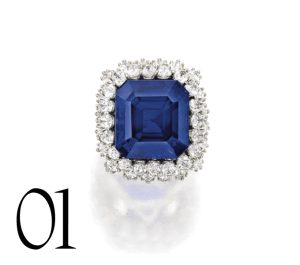
1/8 Kashmir sapphires are bestsellers at auction, and the world record price-per-carat went to a 27.68-ct emerald cut sapphire and diamond “Jewel of Kashmir” ring that sold at Sotheby’s in 2015 for US$6,702,564, or US$242,145 per carat.
The Ancients Greeks wore sapphire when consulting the oracles, believing that the stone could help them understand oracular pronouncements. Hindus related sapphire to the third-eye chakra, providing insight and reflection. Buddhists believed it brought spiritual enlightenment. In the Middle Ages, Christian kings and clergy adorned themselves with sapphire for its protective powers.
A member of the corundum mineral family, sapphire’s name comes from the Greek “sappheiros” or the Latin “saphirus” meaning “blue”. It is thus not surprising that, in legend, history and art, sapphire has been associated with blue.
Wedding Bells and Blue
Aside from centuries-old beliefs of offering protection and good health, sapphire has been linked with royalty and romance. This association received global attention in 1981 when Prince Charles proposed to Lady Diana Spencer with a 12-carat blue sapphire engagement ring. Her ring greatly increased awareness of the gem for bridal jewellery.
“Over the last few years, our customers have been looking for unique natural sapphires one carat and above for the centre for engagement rings,” comments Jen Elliot, co-owner of Coolamon Mining, which has been sourcing sapphires in the Central Queensland Gemfields since 1984.
“Recently, especially with international sales, we have noticed a trend towards smaller sapphires in matched sets of three to five stones as engagement rings.”
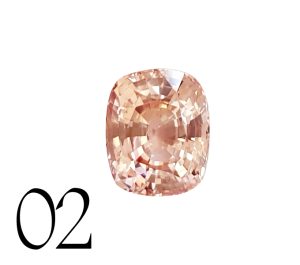
2/8 A 4.75-ct Sri Lankan Padparadscha sapphire from Hamid Bros.
“Sapphire outsells the other gems, and is also very popular now for engagement rings,” says Grant Hamid, owner of Hamid Bros, which sources primarily from Sri Lanka. “It’s hardness—as well as the wide variety of shapes, sizes, and colours—means there is something for virtually every taste and budget.”
Salma Patel of True Blue Opals and Gems, notes, “Sapphires are our best-selling gems, especially the darker blue tones, and we are seeing increased demand for engagement rings as this makes the ring special.”
Rainbow of Colours
Although many think of sapphires as blue, it comes in a wide range of fancy colours— except red. Gem-quality red corundum is called “ruby”. Corundum is allochromatic, meaning that its colours come from trace elements in its chemical structure that produce tones from colourless to shades of green, orange, yellow, blue, pink, peach, purple, grey, black and even multicolours.
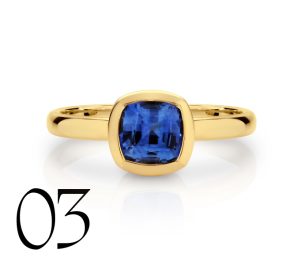
3/8 Sri Lankan blue sapphire and gold ring by Bolton Gems.
“Sapphires are a beautiful, ever popular gemstone and come in every colour under the rainbow,” describes Susie Robson, director of Sovereign Gems. She adds that, because of demand, prices are increasing, and unheated material is at a premium.
Punala Kiripitige, founder of The Gem Monarchy, which sources from its mines in Sri Lanka and Madagascar, says “It’s no mystery that sapphires are the bestselling coloured gemstone,” adding that although blue and pink are regular sellers, colours such as teal are “extremely popular.”
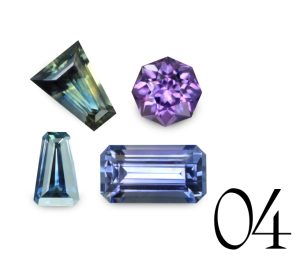
4/8 Selection of sapphires from The Gem Monarchy, counter clockwise from top left: 1.16-ct bi-colour (Madagascar); 0.5-ct purple (Madagascar); 1.79-ct blue (Sri Lanka); 0.3- ct tapered baguette (Madagascar).
The company prides itself in supplying “sapphires that are out of the ordinary, from metallic sapphires to pastel sapphires that vary in saturation from regular colours.”
For Grant Hamid, the “most popular colours are blue and rare peachy/apricot tones, especially Padparadscha, a blend of pink and orange,” adding that pink, purple, yellow, white and green are also good sellers. The company also carries Australian sapphires, with the most demanded colours being blue, teal and parti.
Another company that sources from Sri Lanka and Australia as well as Madagascar is Bolton Gems. “Local sapphires are a fast seller here in Australia, ranging from dark intense blue to amazing parti tones,” explains Dee Bolton. “Ceylon sapphires have a very strong presence here as the Australian market tends to be drawn to the mid-colour range.”
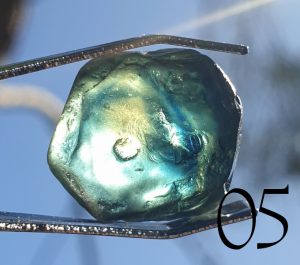
5/8 Rough sample of an Australian parti sapphire from Coolamon Mining.
Jim Elliot, co-owner of Coolamon Mining, explains, “While the strong demand for blue sapphires continues, the demand for parti- colour and teal has increased significantly recently. There is also a demand for our rare golden yellows at the top end of the market.”
Some of history’s most famous sapphires— many of which were considered mystical talismans—are star sapphires, which have inclusions within the gem that create stars— an effect called asterism. Among the famous star sapphires are the 563.4-carat Star of India and the 1404.49-carat Star of Adam, both from Sri Lanka.
While Sri Lanka is a major source of sapphires of all colours, the violet-blue gems traditionally came from India’s Kashmir region and Myanmar and are the most highly prized today. They also command the highest prices at auctions. Other notable sources of sapphires are Madagascar, Australia, Tanzania and the USA.

7/8 One of the more remarkable star sapphires is the 563.35-ct “Star of India,” now in the American Museum of Natural History in New York.
Most sapphires marketed today are heated in order to intensify or lighten colour or improve quality, thus making them more affordable. Yet for the small percentage of untreated stones, demand is high, as are their prices. Regardless of origin or colour, the scintillation of sapphire makes it the perfect birthstone for September.
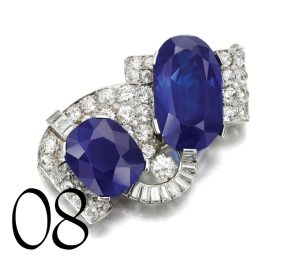
8/8 The largest Kashmir sapphire sold at auction was a 55.19-carat no-heat gem set in a 1930s Cartier brooch along with a 25.97-carat no-heat Kashmir sapphire that sold at Sotheby’s in 2021 for USD3.8 million.
Read below for related stories: